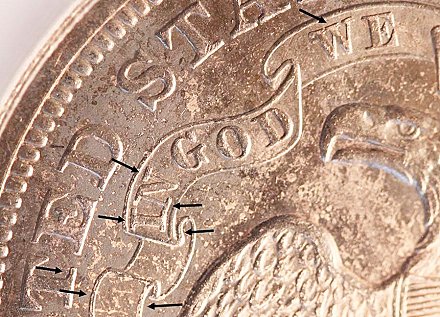|
|
Comments: This is the first of two uses of Obverse P3 and the first of three uses of Reverse PA in 1869. Reverse 1869 PA is transitional, used again in 1870 to strike 1870 OC-P1. |
Obverse P3 The photo below shows the Obverse P3 attribution grid.  1869 Obverse P3 attribution grid Misplaced 6, repunched 1, lumps Obverse P3 can also be identified by the misplaced 6 in the denticles under the right side of the prominent 6. This variety is identified as MPD-001. This obverse also features repunching on the 1, visible under the base, and two small lumps in the field between the base of the 1 and the denticles. All these features are visible in the photo. We've made this variety one of our Top-30.
|
Reverse 1869 PA has no obvious markers, but it does display minor die doubling thatís visible on the left side of the motto and on the adjacent elements. This doubling is indicated by the arrows in the photo below. This is like doubling on several other reverses, particularly Reverse A. The unfinished area between the lower and middle leaves is much smaller on this reverse.  Reverse 1869 PA die doubling
|
| Photo credits:
Obverse P3: 1869 PCGS PR61 (mis-attributed as a proof by PCGS), from the Osburn-Cushing reference collection. Reverse PA: 1869 PCGS PR63, from the Osburn-Cushing reference collection. |
